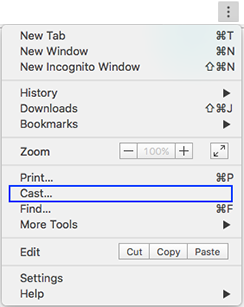O SDK do remetente da Web é compatível com navegadores da Web compatíveis com Cast no Mac, Windows, Dispositivos Linux, ChromeOS e Android. Para apps nativos do Google Cast para dispositivos móveis, consulte Apps Android e Apps iOS.
Configuração
Adicionar a biblioteca da API Web Sender ao projeto
Para usar a API Web Sender, inclua o script a seguir na sua página da Web:
<script src="//www.gstatic.com/cv/js/sender/v1/cast_sender.js?loadCastFramework=1"></script>
Registro
Além de registrar o app e o dispositivo do receptor da Web, nenhuma etapa especial de configuração é necessária para usar o SDK do remetente da Web.
Para registrar seu app e dispositivo receptor da Web, siga as etapas em Registro. Assim que tiver o ID do aplicativo, você está pronto para desenvolver o aplicativo Web Sender.
Como testar botões Transmitir
Embora o app Remetente da Web deva ter um botão Transmitir próprio, o usuário também pode invoque o recurso de transmissão selecionando Transmitir no menu do botão direito, conforme mostrado aqui:

O app Web Sender deve processar os dois casos.
Canal Beta do Chrome
Um canal Beta público para o Chrome também está disponível. Novas versões do Chrome são enviados ao Canal Beta antes do lançamento completo; o Canal Beta também está atualizados com mais frequência do que o Canal Stable. Isso dá aos desenvolvedores (e usuários iniciais entusiasmados) avançam o acesso a novos recursos e permitem garantir que seu site funcione com as próximas versões do Chrome.
Para usar o Canal Beta público:
- Instalar a versão Beta do Chrome
- Para informar problemas, clique com o botão direito do mouse no ícone do Google Cast na barra de ferramentas e escolha "Informar um problema". problema". Não podemos responder individualmente à maioria dos feedbacks, mas valorizamos muito a entrada no Canal Beta.
- Antes de enviar atualizações ao seu site ativo, teste com o versão estável atual do Chrome. A maioria dos visitantes do site terá versão estável do Google Chrome instalada e, se você depende de recursos exclusivos da versão beta, os usuários com a versão estável serão afetados.
